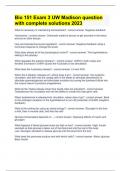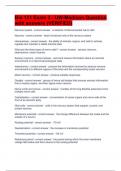Bio 151 exam 3 - Study guides, Class notes & Summaries
Looking for the best study guides, study notes and summaries about Bio 151 exam 3? On this page you'll find 115 study documents about Bio 151 exam 3.
All 115 results
Sort by
Bio 151 Exam 3 UW Madison question with complete solutions 2023
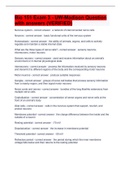
-
Bio 151 Exam 3 - UW-Madison Question with answers (VERIFIED)
- Exam (elaborations) • 5 pages • 2023
-
Available in package deal
-
- $15.99
- 1x sold
- + learn more
Bio 151 Exam 3 - UW-Madison Question with answers (VERIFIED)Nervous system a network of interconnected nerve cells Neurons basic functional units of the nervous system Homeostasis the ability of animals, organs, and cells to actively regulate and maintain a stable internal state What are the three types of nerve cells? sensory neurons, interneurons, motor neurons Sensory neurons send and receive information about an animal's environment or it internal physiologi...

-
Bundle for portage learning BIO 103 medical terminology Module Case Study graded A
- Package deal • 16 items • 2023
-
- $28.39
- 1x sold
- + learn more
Exam (elaborations) portage learning BIO 103 medical terminology Module Module 7 Case Study graded A 2 Exam (elaborations) portage learning BIO 103 medical terminology Module 1-7 Case Study latest complete test graded A 3 Exam (elaborations) portage medical terminology module 1 LATEST 2023 4 Exam (elaborations) BIOD 151 Module 1 Exam 2023 - Por
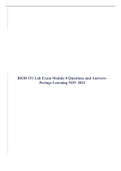
-
BIOD 151 Module 5, 6 ,7 and FINAL Exam, LABS 6,7 and 8 PACKAGE 2023- Portage Learning
- Package deal • 7 items • 2023
-
- $35.00
- 2x sold
- + learn more
1 Exam (elaborations) BIO 151 Module 5 Exam Questions and Answers Essential Human Anatomy and Physiology 1 - Portage Learning 2023 2 Exam (elaborations) BIOD 151 A and P 151 Module 6 Exam October 2022- Portage Learning 3 Exam (elaborations) BIOD 151 A and P 151 Module 7 Exam October 2022- Portage Learning 4 Exam (elaborations) BIOD 151 Lab Exam
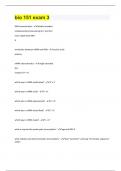
-
bio 151 exam 3| Questions With 100% Correct Answers | Verified
- Exam (elaborations) • 20 pages • 2023
-
- $11.49
- + learn more
DNA characteristics - double stranded complementary base pairing A=T and G=C more stable than RNA H similarities between mRNA and DNA - nucleic acids polarity mRNA characteristics - single stranded OH instead of T-->U which way is mRNA synthesized? - 3'-> 5' which way is mRNA read? - 3'->5' which was is mRNA polymerized? - 3'-> 5' which was is mRNA transcribed? - 3'-> 5' which way is mRNA made? - 5'-->3' what is required for prokaryotic transcription? - ...
Bio 151 Exam 3 Question and answers already passed 2023
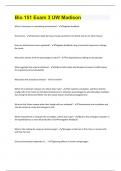
-
Bio 151 Exam 3 UW Madison| Questions with 100% Correct Answers | Verified
- Exam (elaborations) • 9 pages • 2023
-
- $5.99
- + learn more
What is necessary in maintaining homeostasis? - Negative feedback Horomones - Chemicals made by tissues to get secreted in the blood and act on other tissues How are testosterone levels regulated? - Negative feedback using a hormonal response to change the levels What does almost all of the physiological control? - The hypothalamus talking to the pituitary What regulates the anterior pituitary? - GnRH in both males and females (increase in GnRH causes the A pituitary to be stimulated) Wha...
BIO 151 EXAM 3 Question and answer 100% correct 2023
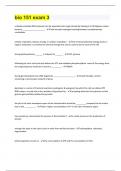
-
bio 151 exam 3| Questions With 100% Correct Answers | Verified
- Exam (elaborations) • 6 pages • 2023
-
- $6.99
- + learn more
a double-stranded DNA molecule can be separated into single strands by heating it to 90 degrees celsius because ____________________ - heat disrupts hydrogen bonding between complementary nucleotides cellular respiration releases energy. in cellular respiration: - the chemical potential energy stores in organic molecules is converted to chemical energy that can be used to do the work of the cell during photosynthesis, ______ is reduced to _______ - CO2; glucose following the citric acid cy...
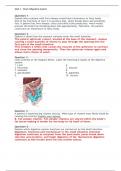
-
BIO 151 A&P 1 Module 3 Exam Summer 2023 portage learning
- Exam (elaborations) • 5 pages • 2023
-
Available in package deal
-
- $11.49
- 1x sold
- + learn more
A&P 1 – Mod 3 Digestive System Exam Question 1 Explain why a patient with liver disease would have intolerance to fatty foods. One of the functions of liver is to produce bile, which breaks down and emulsifies fats. If patient has liver disease, that could affect bile production, which would prevent the body from breaking down fats appropriately. Therefore, the patient could have an intolerance to fatty foods. Question 2 Explain in detail how the stomach contents enter the small intest...

Study stress? For sellers on Stuvia, these are actually golden times. KA-CHING! Earn from your study resources too and start uploading now. Discover all about earning on Stuvia

